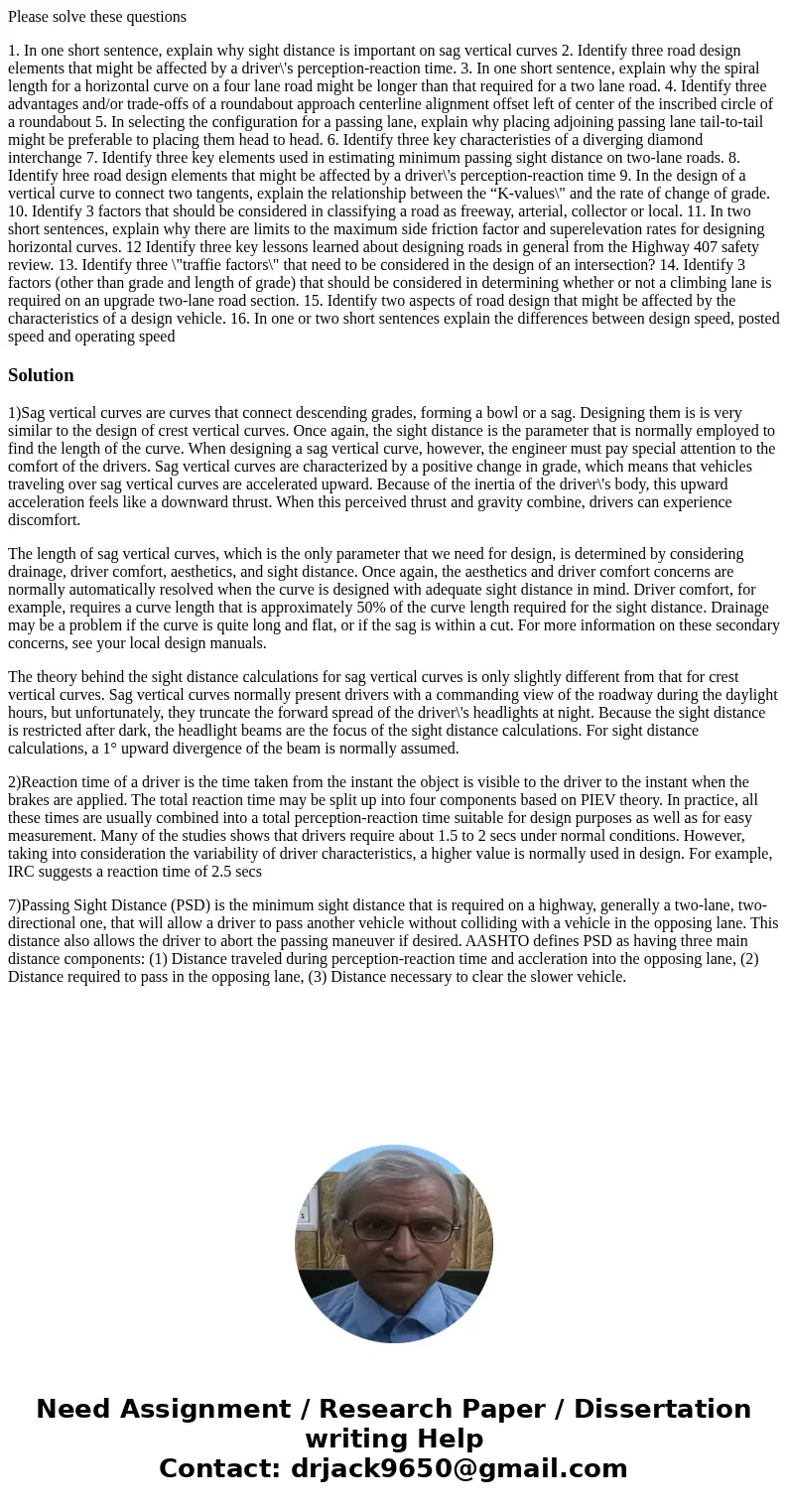Please solve these questions 1 In one short sentence explain
Please solve these questions
1. In one short sentence, explain why sight distance is important on sag vertical curves 2. Identify three road design elements that might be affected by a driver\'s perception-reaction time. 3. In one short sentence, explain why the spiral length for a horizontal curve on a four lane road might be longer than that required for a two lane road. 4. Identify three advantages and/or trade-offs of a roundabout approach centerline alignment offset left of center of the inscribed circle of a roundabout 5. In selecting the configuration for a passing lane, explain why placing adjoining passing lane tail-to-tail might be preferable to placing them head to head. 6. Identify three key characteristies of a diverging diamond interchange 7. Identify three key elements used in estimating minimum passing sight distance on two-lane roads. 8. Identify hree road design elements that might be affected by a driver\'s perception-reaction time 9. In the design of a vertical curve to connect two tangents, explain the relationship between the “K-values\" and the rate of change of grade. 10. Identify 3 factors that should be considered in classifying a road as freeway, arterial, collector or local. 11. In two short sentences, explain why there are limits to the maximum side friction factor and superelevation rates for designing horizontal curves. 12 Identify three key lessons learned about designing roads in general from the Highway 407 safety review. 13. Identify three \"traffie factors\" that need to be considered in the design of an intersection? 14. Identify 3 factors (other than grade and length of grade) that should be considered in determining whether or not a climbing lane is required on an upgrade two-lane road section. 15. Identify two aspects of road design that might be affected by the characteristics of a design vehicle. 16. In one or two short sentences explain the differences between design speed, posted speed and operating speedSolution
1)Sag vertical curves are curves that connect descending grades, forming a bowl or a sag. Designing them is is very similar to the design of crest vertical curves. Once again, the sight distance is the parameter that is normally employed to find the length of the curve. When designing a sag vertical curve, however, the engineer must pay special attention to the comfort of the drivers. Sag vertical curves are characterized by a positive change in grade, which means that vehicles traveling over sag vertical curves are accelerated upward. Because of the inertia of the driver\'s body, this upward acceleration feels like a downward thrust. When this perceived thrust and gravity combine, drivers can experience discomfort.
The length of sag vertical curves, which is the only parameter that we need for design, is determined by considering drainage, driver comfort, aesthetics, and sight distance. Once again, the aesthetics and driver comfort concerns are normally automatically resolved when the curve is designed with adequate sight distance in mind. Driver comfort, for example, requires a curve length that is approximately 50% of the curve length required for the sight distance. Drainage may be a problem if the curve is quite long and flat, or if the sag is within a cut. For more information on these secondary concerns, see your local design manuals.
The theory behind the sight distance calculations for sag vertical curves is only slightly different from that for crest vertical curves. Sag vertical curves normally present drivers with a commanding view of the roadway during the daylight hours, but unfortunately, they truncate the forward spread of the driver\'s headlights at night. Because the sight distance is restricted after dark, the headlight beams are the focus of the sight distance calculations. For sight distance calculations, a 1° upward divergence of the beam is normally assumed.
2)Reaction time of a driver is the time taken from the instant the object is visible to the driver to the instant when the brakes are applied. The total reaction time may be split up into four components based on PIEV theory. In practice, all these times are usually combined into a total perception-reaction time suitable for design purposes as well as for easy measurement. Many of the studies shows that drivers require about 1.5 to 2 secs under normal conditions. However, taking into consideration the variability of driver characteristics, a higher value is normally used in design. For example, IRC suggests a reaction time of 2.5 secs
7)Passing Sight Distance (PSD) is the minimum sight distance that is required on a highway, generally a two-lane, two-directional one, that will allow a driver to pass another vehicle without colliding with a vehicle in the opposing lane. This distance also allows the driver to abort the passing maneuver if desired. AASHTO defines PSD as having three main distance components: (1) Distance traveled during perception-reaction time and accleration into the opposing lane, (2) Distance required to pass in the opposing lane, (3) Distance necessary to clear the slower vehicle.

 Homework Sourse
Homework Sourse